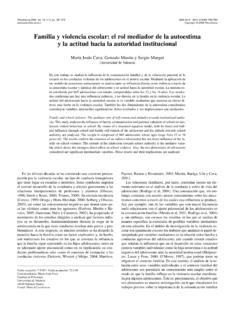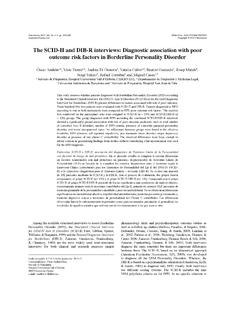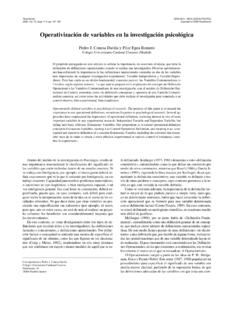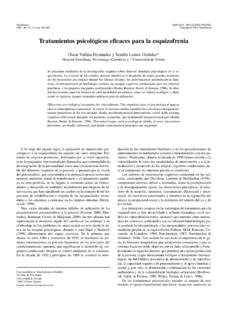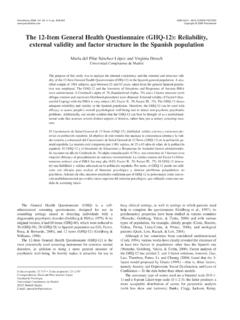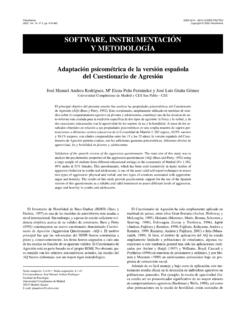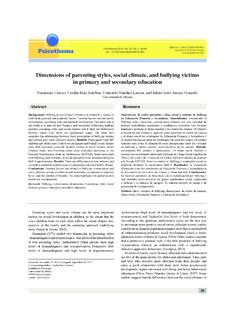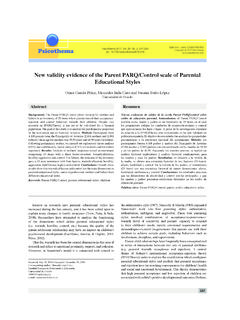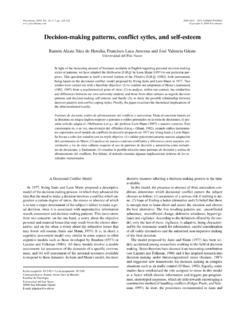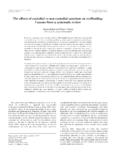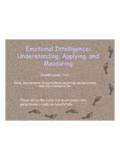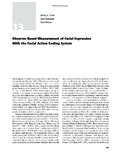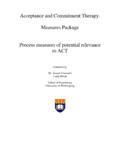Transcription of Measuring emotional intelligence with the Mayer …
1 We use the term emotional intelligence (EI) to refer to themental processes involved in the recognition, use, understanding,and management of one s own and others emotional states tosolve problems and regulate behavior ( Mayer & Salovey, 1997;Salovey & Mayer , 1990). That is, we view EI as ability- orcompetency-based (cf. Saarni, 1999), as distinguished from beingrooted in personality attributes (see Brackett & Mayer , 2003; Mayer , Salovey, & Caruso, 2000 for theoretical and empiricaldistinctions). emotional intelligence from this tradition refers toan individual s capacity to reason about emotions and to processemotional information in order to enhance cognitive two journal articles in 1990, we formally defined EI andpresented a preliminary demonstration of how the constructcould be measured as an ability ( Mayer , DiPaolo, & Salovey,1990; Salovey & Mayer , 1990).
2 Our initial definition of EI was the ability to monitor one s own and others feelings andemotions, to discriminate among them and to use thisinformation to guide one s thinking and actions (Salovey & Mayer , 1990, p. 189). We then refined our thinking about EI andpublished a four-branch model, which defined EI as the ability to(a) perceive emotion, (b) use emotion to facilitate thought, (c)understand emotions, and (d) manage emotion ( Mayer &Salovey, 1997).This manuscript focuses on the Mayer -Salovey-CarusoEmotional intelligence Test (MSCEIT; Mayer , Salovey, & Caruso,2002a), which was designed to measure the four-branch model ofEI. Here, we describe the MSCEIT, its psychometric properties,and recent validation studies with the instrument (see also Mayer ,Salovey, & Caruso, 2002b). Evidence supports the idea that EI(operationalized by the MSCEIT) meets classical criteria of astandard intelligence and predicts outcomes of social importance( Mayer , Salovey, Caruso, & Sitarenios, 2001, 2003).
3 To acquaintthe reader with our theory of EI, we begin with a brief review ofMeasuring emotional intelligence with the Mayer -Salovery-CarusoEmotional intelligence Test (MSCEIT)Marc A. Brackett and Peter SaloveyYale UniversityThis manuscript examines the measurement instrument developed from the ability model of EI (Ma-yer and Salovey, 1997), the Mayer -Salovey-Caruso emotional intelligence Test (MSCEIT; Mayer , Sa-lovey and Caruso, 2002). The four subtests, scoring methods, psychometric properties, reliability, andfactor structure of the MSCEIT are discussed, with a special focus on the discriminant, convergent,predictive, and incremental validity of the test. The authors review associations between MSCEIT sco-res and important outcomes such as academic performance, cognitive processes, psychological well-being, depression, anxiety, prosocial and maladaptive behavior, and leadership and organizational be-havior.
4 Findings regarding the low correlations between MSCEIT scores and self-report measures ofEI also are presented. In the conclusion the authors provide potential directions for future research onemotional medida de la inteligencia emocional con el Mayer -Salovey-Caruso emotional intelligence Test(MSCEIT). Este art culo examina el instrumento de medida desarrollado desde el modelo de habili-dad de IE ( Mayer y Salovey, 1997), el Mayer -Salovey-Caruso emotional intelligence Test (MS-CEIT; Mayer , Salovey y Caruso, 2002). Brevemente, se presenta el modelo de cuatro ramas de art culo examina el MSCEIT, sus subescalas, el m todo de puntuaci n, las propiedades psicom -tricas, su fiabilidad y estructura factorial. Varios estudios han utilizado el MSCEIT y han demostra-do la validez discriminante, convergente, predictiva e incremental del test. El instrumento muestrauna validez discriminante apropiada respecto a otros constructos cl sicos como las habilidades cog-nitivas o los rasgos de personalidad.
5 Adem s, se justifican las bajas correlaciones encontradas entrelas puntuaciones del MSCEIT y las medidas autoinformadas de IE. Finalmente, los autores revisanla evidencia emp rica que demuestra la validez incremental del test para predecir resultados impor-tantes como rendimiento acad mico, procesos cognitivos, bienestar psicol gico, depresi n, ansie-dad, conducta prosocial y conductas no adaptativas, y comportamiento organizacional y de lideraz-go. Para concluir, los autores animan a investigar en diferentes l neas siguiendo su modelo de IEutilizando el MSCEIT. Correspondence: Marc A. BrackettFaculty of ???Yale Box 208241 (USA)E-mail: 2006. Vol. 18, supl., pp. 34-41 ISSN 0214 - 9915 CODEN 2006 Psicothemathe four-branch model. Elsewhere, the theory is described in moredetail ( Mayer & Salovey, 1997; Salovey, Bedell, Detweiler, & Mayer , 2000; Salovey, Mayer , & Caruso, 2002).Four-Branch model of emotional intelligenceOur analyses of emotion-related abilities led us to conceive ofEI as comprised of four branches or abilities, as illustrated in table1.
6 Whereas the perception, understanding, and management ofemotions (Branches 1, 3, and 4) involve reasoning about emotions,Branch 2 (the use of emotions to facilitate thought) involves usingemotions to enhance reasoning. Perceiving emotion The first branch of EI is defined as the ability to perceive andidentify emotions in oneself and others, as well as in other stimuliincluding people s voices, stories, music, and works of art ( ,Ekman & Friesen, 1975; Nowicki & Mitchell, 1998; Scherer,Banse, & Wallbott, 2001). When focused on the self, thisdimension is related to greater emotional awareness (Lane,Quinlan, Schwartz, Walker, & Zeitlin, 1990), lower alexithymia(Apfel & Sifneos, 1979), and less ambivalence about emotionalexpressivity (King, 1998; King & Emmons, 1990). When focusedon other people, this dimension encompasses what is meant byaffect sensitivity (Campbell, Kagan, & Krathwohl, 1971), affect-receiving ability (Buck, 1976) and nonverbal sensitivity(Rosenthal, Hall, DiMatteo, Rogers, & Archer, 1979).
7 Use of emotion to facilitate thoughtThe second branch of EI concerns the ability to use emotions tofocus attention and to think more rationally, logically, andcreatively. Using emotions may require the ability to harnessfeelings that assist in certain cognitive enterprises such asreasoning, problem-solving, decision-making, and interpersonalcommunication. Emotions can create diverse mental sets that provemore and less adaptive for various kinds of reasoning tasks (Isen,1987; Palfai & Salovey, 1993; Schwarz, 1990; Schwarz & Clore,1996). For example, some emotions may be more useful instimulating creative thought (Isen & Daubman, 1984; Isen,Daubman, & Nowicki, 1987) and there may be a feedback loopwherein some people are especially creative in their experiences ofemotion (Averill, 1999, 2000; Averill & Nunley, 1992).Understanding emotionThe third branch of EI, understanding emotions, involves a fairamount of language and propositional thought to reflect thecapacity to analyze emotions.
8 It includes an understanding of theemotional lexicon and the manner in which emotions combine,progress, and transition from one to the other. Individuals who areskilled at understanding emotions have a particularly rich feelingsvocabulary and appreciate the relationships among termsdescribing different feeling states. They may be especiallysensitive to the manner in which emotion words are arranged asfuzzy sets organized around emotional prototypes (Ortony, Clore,& Collins, 1988), and adept at identifying the core meaning orthemes behind various emotional experiences (Lazarus, 1991).Managing emotion The ability to regulate moods and emotions in oneself and inother people constitutes the fourth branch of EI. When managingone s own feelings, people must be able to monitor, discriminate,and label their feelings accurately, believe that they can improveor otherwise modify these feelings, employ strategies that willalter their feelings, and assess the effectiveness of these investigators have identified clear individual differencesin at least some people s perceived self-efficacy with respect tothis ability (Catanzaro & Greenwood, 1994; Salovey, Mayer ,Goldman, Turvey, & Palfai, 1995).
9 Some people are also more orless effective in helping others to mange their emotions. Forexample, some individuals always know the right thing to say ordo to cheer up their best friend, to motivate a colleague at work, orto inspire others, whereas other individuals are less capable ofeffecting these outcomes ( , Wasielewski, 1985). Measuring emotional intelligence with the MSCEITThe four EI abilities were first measured with a test called theMultifactor emotional intelligence Test (MEIS; Mayer , Caruso, &Salovey, 1999). This instrument was improved upon, leading to abriefer test that was produced professionally, the MSCEIT ( Mayer , Measuring emotional intelligence WITH THE Mayer -SALOVEY-CARUSO emotional intelligence TEST (MSCEIT)35 Table 1 The four-branch model of emotional intelligenceEmotional intelligenceBranch nameBrief description of skills involvedPerception of emotionThe ability to perceive emotions in oneself and others, as well as in objects, art, stories, music and other stimuli (Branch 1)Use of emotion to facilitate thinkingThe ability to generate, use, and feel emotion as necessary to communicate feelings, or employ them in other cognitive processes(Branch 2)Understanding of emotionThe ability to understand emotional information, how emotions combine and progress through relationship transitions and to appreciate such emotio-(Branch 3))
10 Nal meaningsManagement of emotionThe ability to be open to feelings, to modulate them in oneself and others so as to promote personal understanding and growth(Branch 4)Salovey, & Caruso, 2002a). The items developed for the MEIS served as the starting point for the MSCEIT. However, severaliterations took place in the development of the current MSCEITV ersion The MSCEIT assesses the four-branch model of EI (perceiving,using, understanding, and regulating emotions) with 141 itemsthat are divided among 8 tasks (two for each branch). The testyields seven scores: one for each of the four branches, two areascores, and a total EI score. The two area scores are termed:Experiential EI (branches 1 and 2 combined), and Strategic EI(branches 3 and 4 combined). Mayer et al. (2001, 2003) assert that the emotional abilitiesmeasured by the MSCEIT meet classical criteria for anintelligence because: (a) the MSCEIT has a factor structurecongruent with the four branches of the theoretical model; (b) thefour abilities show unique variance, but are meaningfully relatedto other mental abilities such as verbal intelligence ; (c) EIdevelops with age and experience, and finally; (d) the abilities canbe objectively subtestsThe first branch of EI, Perceiving Emotions, is measured byasking respondents to identify the emotions expressed inphotographs of people s faces (Faces) as well as the feelingssuggested by artistic designs and landscapes (Pictures).
